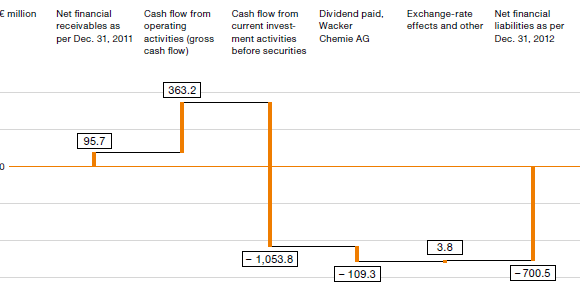Our main financial-management goal is to maintain WACKER’s financial strength. The focal task is to sufficiently cover the financial needs of our operational business and investment projects. Financial management at the Group is centrally organized. It handles cash management and financing, as well as hedging against currency and interest-rate risks. A groupwide financial regulation sets out tasks and responsibilities. As part of liquidity management, we continuously monitor payment flows from operations and financial business. WACKER covers its resultant liquidity needs via suitable instruments, such as intra-Group financing through borrowings, or through external loans from local banks. We receive the necessary outside funding via contractually-agreed credit lines in various currencies and with differing terms. We invest liquidity surpluses on money and capital markets with an optimum risk/return rate.
WACKER pursues a careful financing policy targeted at a balanced financing portfolio, a diversified maturity portfolio and a comfortable liquidity buffer. In addition to the financing instruments already mentioned, WACKER expects to be able to tap the bond markets and other instruments, if necessary. Our aim is to maintain our corporate financial structures so that the Group’s credit rating remains – at a minimum – in the investment-grade range.
WACKER’s key liquidity source is the operations of its Group companies and the resultant incoming payments. As part of our cash-management systems, liquidity surpluses at individual Group companies are used to cover the financing needs of other Group companies. Centralized in-house financial settlements reduce external-borrowing amounts and interest costs.
Financial Analysis
As of December 31, 2012, financial liabilities amounted to €1.20 billion, up €419.3 million on 2011 (€777.9 million). On February 23, 2012, WACKER issued four promissory notes (German Schuldscheine) totaling €300 million, as part of its multiyear financing strategy. They have terms of three and five years, and contain standard market credit terms. Additionally, we raised a long-term loan in both Q3 and Q4, each totaling 5 billion Japanese yen. By concluding these two transactions, WACKER has secured long-term financing at attractive interest rates, while at the same time improving the maturity profile of its financial debt even further.
WACKER defines net financial liabilities – a key indicator – as the balance of gross financial debt (obligations to banks, including finance-lease obligations) and existing noncurrent and current liquidity, consisting of securities, cash and cash equivalents. The net financial liabilities reported for 2012 reflect our investment activity and the resulting capital requirements. At the reporting date, we had net financial liabilities totaling €700.5 million. In 2011, WACKER had net financial receivables of €95.7 million. WACKER invested a total of €1.10 billion in property, plant and equipment and in financial assets – equivalent to an investment ratio, based on total Group sales, of 24 percent (2011: 20 percent). The investments will enhance WACKER’s global competitive position in the future.
Aside from the financial liabilities disclosed in the report on net assets, WACKER has at its disposal adequate unused credit lines with terms of of over one year totaling some €640 million as of the reporting date. In Q2 2012, WACKER arranged a €400 million syndicated credit facility with a term of five years. Conversely, an existing syndicated loan of €300 million raised in 2007 was redeemed prematurely. Thus, we have enough financial leeway to secure the Group’s continued growth. The Group does not use any off-balance-sheet financing components.
Net Financial Liabilities/Receivables
